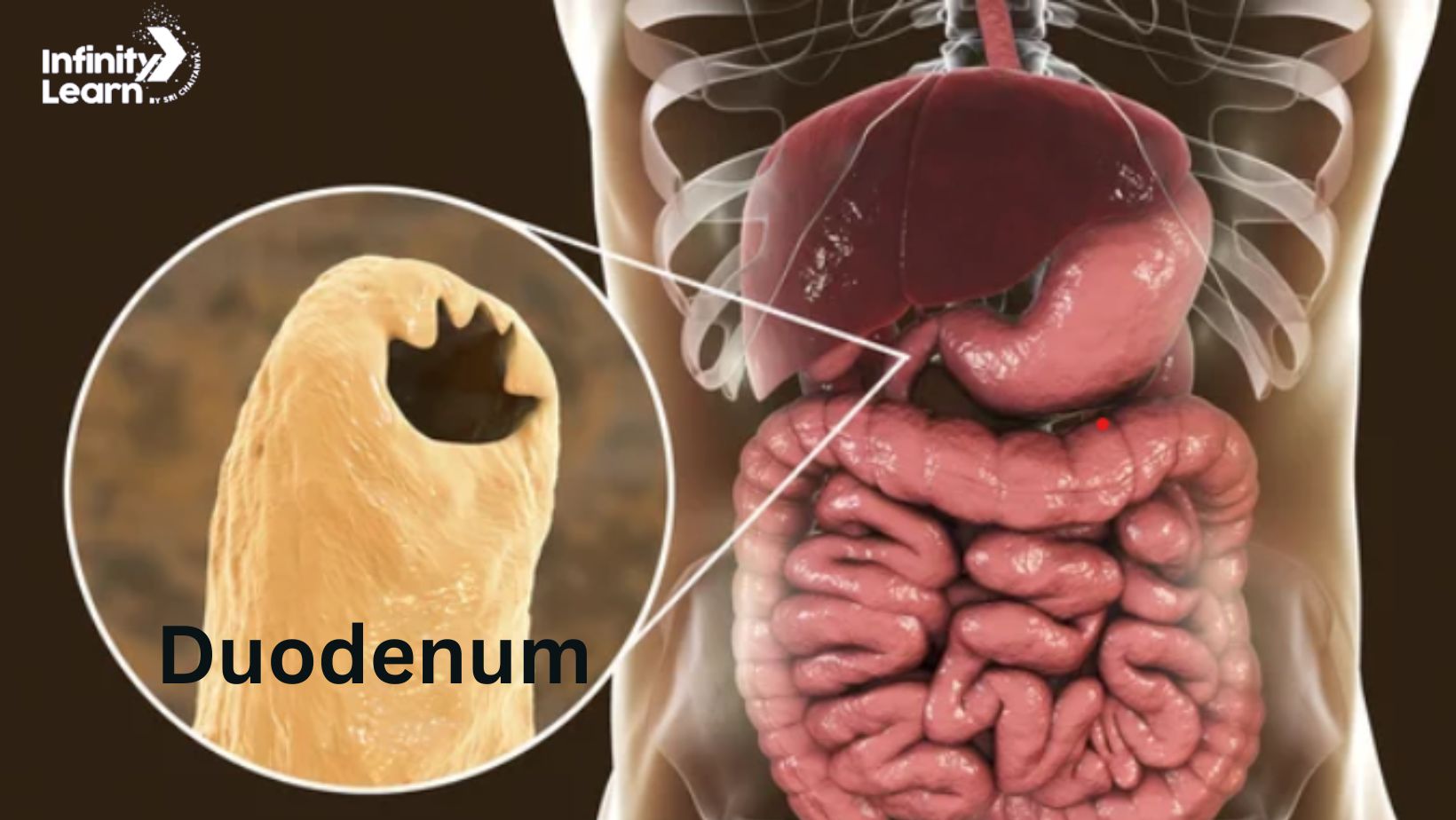Table of Contents
The duodenum is the beginning of the small intestine. It’s linked to the stomach. This part of the intestine continues breaking down food from the stomach. It takes in essential nutrients like vitamins, minerals, fats, proteins, and water from the food. These nutrients are then used by the body.
Also Check: Organisms Reproduce Class 10
What is Duodenum?
The duodenum, which is the first part of the small intestine, serves as a vital connection from the stomach. Its main job is to continue breaking down the food that comes from the stomach. Additionally, it’s responsible for absorbing important nutrients such as vitamins, minerals, carbohydrates, fats, and proteins, as well as water, which are all essential for the body’s functioning.

Types of Duodenum
The duodenum can be split into four sections: Superior, descending, inferior and Ascending. These parts make a curved shape, about 25cm long, and they wrap around the pancreas’s head.
Superior (Spinal level L1)
The first part of the duodenum is called ‘the cap’. It goes up from the lower part of the stomach, and is linked to the liver by a ligament called hepatoduodenal. This spot is where duodenal ulcers commonly happen.
Also Check: CBSE Class 10 Science Syllabus
The top 3cm of the upper duodenum has a covering of peritoneum in front and behind, while the rest is behind the peritoneum.
Descending (L1-L3)
The part that goes down curves below the pancreas. It’s behind the transverse colon and in front of the right kidney.
Inside, there’s a spot called the major duodenal papilla – it’s where bile and pancreatic juices enter from the ampulla of Vater.
Also Check: Life Process
Inferior (L3)
The lower duodenum moves to the left, crossing over the inferior vena cava and aorta. It’s below the pancreas and behind the superior mesenteric artery and vein.
Ascending (L3-L2)
After crossing the aorta, the duodenum goes up and curves in front to meet the jejunum at a sharp bend called the duodenojejunal flexure.
At this bend, there’s a piece of muscle called the suspensory muscle of the duodenum. When this muscle tightens, it widens the bend and helps move the stuff in the intestine into the jejunum.
Duodenum Length
Located below the stomach, the duodenum is about 25 to 30 cm long. It’s interesting to note that its name comes from its length. In Latin, “duodenum” means “12 fingers,” which is roughly how long the duodenum is.
Also Check: Anaerobic Respiration
Crohn Disease of the Duodenum
Patients who have problems in their duodenum might feel discomfort or pain in their upper abdomen, lose their appetite, and face problems like feeling full too quickly, nausea, vomiting, or losing weight. These problems can be caused by inflammation, narrowings, or abnormal connections called fistulas in the duodenum. If these problems persist for a long time, there’s a higher chance of developing duodenal cancer.
Duodenum Function
After food is digested in the stomach and mixed with stomach acid, it moves on to the duodenum. Here, it combines with bile from the gallbladder and digestive juices from the pancreas. The duodenum is where the process of absorbing vitamins, minerals, and other nutrients from the food begins.
Duodenum and Digestive Function
The main job of the duodenum is to start breaking down and soaking up the nutrients our bodies need from the food we eat. It gets this process going by getting the chyme (the semi-digested food from the stomach) ready for absorbing nutrients easily.
While our mouths start the digestion process with saliva, the food we swallow moves down the esophagus into the stomach, where it mixes with stomach acid. From there, it goes into the duodenum, where our bodies start absorbing important stuff like vitamins and minerals.
The duodenum is like a big mixing bowl in the small intestine. It stirs up the chyme with enzymes to break down food, adds stuff like bicarbonate to balance out acids, and gets the chyme ready for breaking down fats and proteins in the jejunum, where most of the nutrient absorption happens.
Some specific jobs of the duodenum are:
- Taking in the mixed-up food from the stomach.
- Balancing out the acidity in the chyme.
- Moving digestion along with help from bile from the liver, enzymes from the pancreas, and juices from the duodenum walls and other digestive organs.
- Preparing the chyme for further breakdown by mixing in bile to help with fats.
- Soaking up certain nutrients, like folate, iron, and vitamin D.
Also Check: CBSE Syllabus for Class 10
Duodenum FAQs
What is the duodenum and its function?
The duodenum is the first part of the small intestine. Its main function is to receive partially digested food from the stomach and mix it with digestive juices from the pancreas and gallbladder to continue digestion.
What are the 4 parts of the duodenum?
The four parts of the duodenum are the superior (first) part, descending (second) part, horizontal (third) part, and ascending (fourth) part.
What is the duodenum highly responsible for?
The duodenum is highly responsible for the breakdown of food and the absorption of nutrients, especially important minerals and vitamins.
What is the function of the jejunum and the ileum?
The jejunum and ileum, which are parts of the small intestine following the duodenum, mainly absorb nutrients from digested food and transfer them into the bloodstream.
How is food digested in the duodenum?
Food is digested in the duodenum through the action of digestive enzymes from the pancreas and bile from the gallbladder, which break down proteins, fats, and carbohydrates into smaller molecules for absorption.
What is the duodenum 1st 2nd 3rd 4th?
The duodenum's first part receives food from the stomach. The second part descends, the third part runs horizontally, and the fourth part ascends before connecting to the jejunum, the next part of the small intestine.








